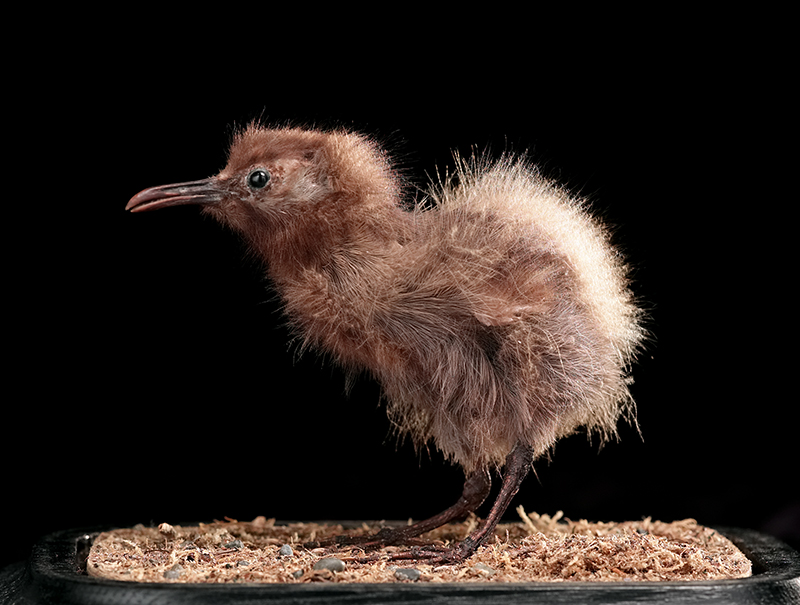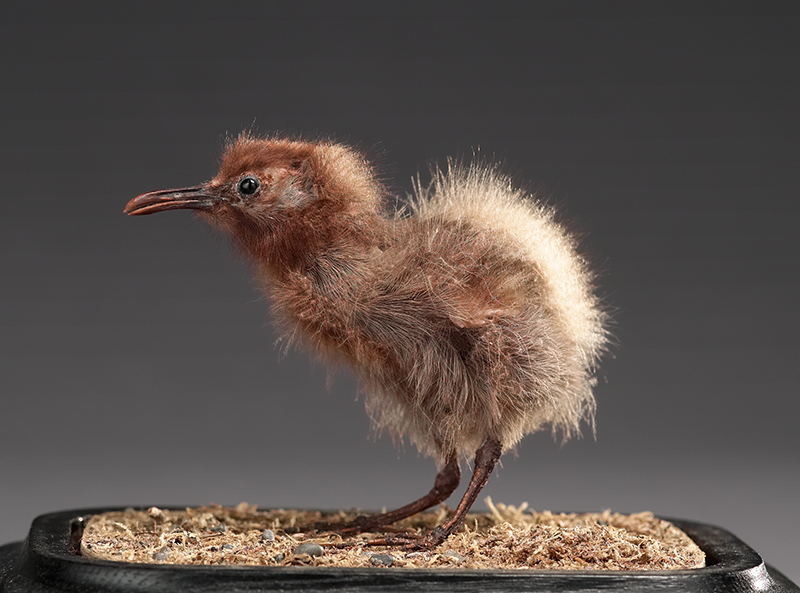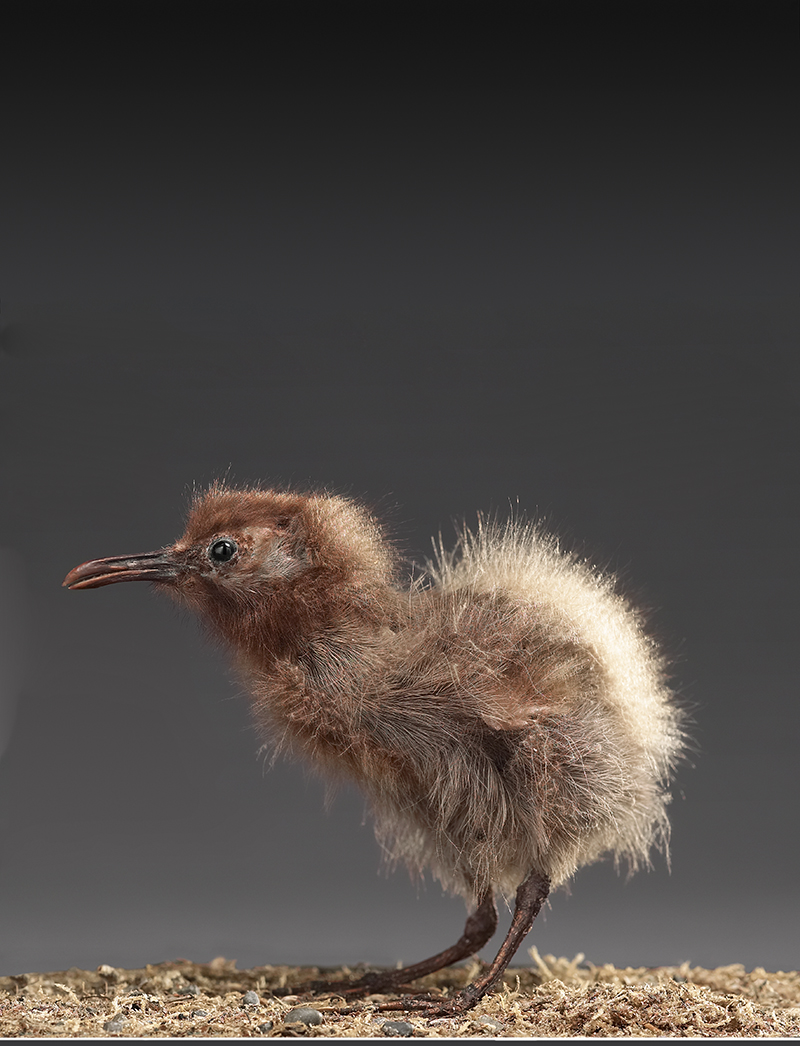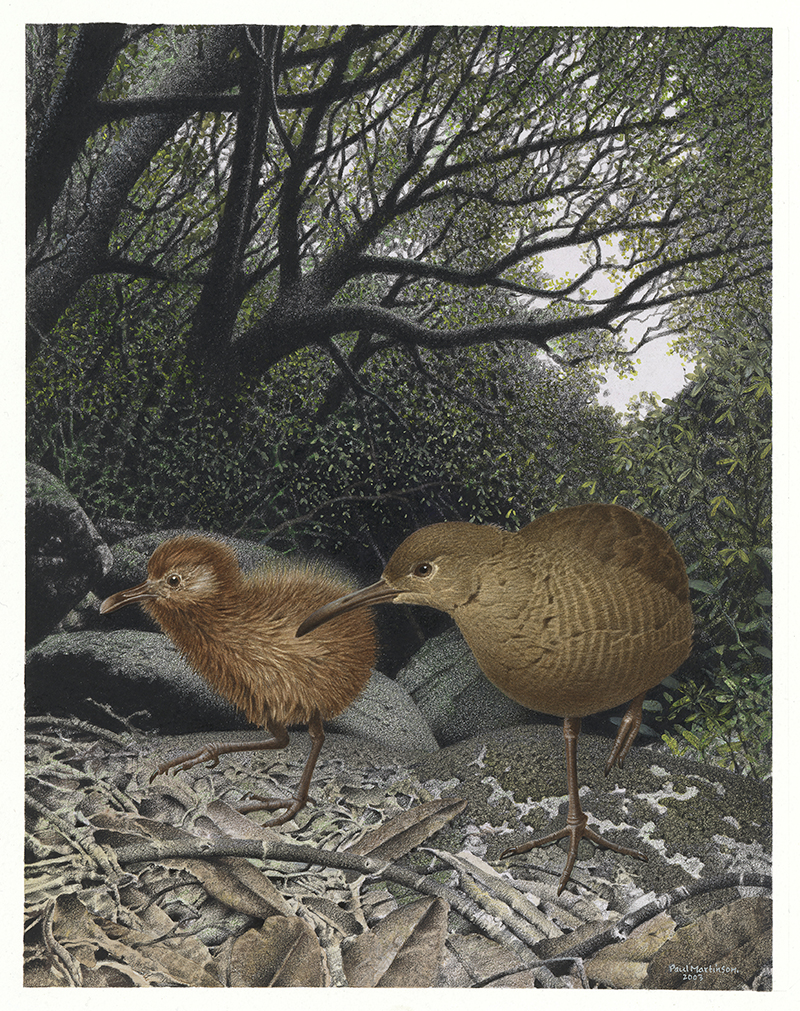Cabalus modestus (Hutton, 1872:247)
Chatham rail, Chatham Islands rail, Chatham Island rail, Mātirakahu (Māori)
Taxonomy & Nomenclature
A complete synonymy taken from (Checklist Committee (OSNZ), 2022:57-58):
Rallus modestus Hutton, 1872: Ibis 2 (3rd series): 247 – Mangere Island, Chatham Islands.; Rallus dieffenbachii G.R. Gray; Buller 1872 (Dec.), History of the Birds of N.Z., 1st edition (part 3): 179. In part.; Cabalus dieffenbachii (G.R. Gray); Sharpe 1875, Zool. Voy. ‘Erebus’ & ‘Terror’, Birds – 1 (Appendix): 29. In part.; Cabalus modestus (Hutton); Buller 1888 (Nov.), History of the Birds of N.Z., 2nd edition 2 (part 10): 123.; Ocydromus pygmaeus Forbes, 1892: Nature 46: 252 – Chatham Islands.; Rallus modestus Hutton; Checklist Committee 1990, Checklist Birds N.Z.: 119.; Gallirallus modestus (Hutton); Trewick 1997, Journ. Royal Soc. N.Z. 27: 452.; Cabalus modestus (Hutton); Holdaway et al. 2001, New Zealand Journ. Zool. 28(2): 132, 178.
Conservation Status
Extinct (WCMC, 1992:212)
Last record: 1893 (Tennyson & Martinson, 2007); 1895 (Kittelberger et al., 2024); 1895-1900 (Greenway, 1967); 1900 (Fleming, 1939; WCMC, 1992:212)
IUCN RedList status: Extinct
Distribution
Chatham Islands (Chatham, Mangere and Pitt Islands only), New Zealand
Biology & Ecology
Hypodigm
There are 34 preserved specimens worldwide (Tennyson & Martinson, 2006). However, Tennyson & Bartle (2008:196) could only trace the syntype in the Museum of New Zealand Te Papa Tongarewa collection.
Museum of New Zealand Te Papa Tongarewa:
Media

Above: Chatham Island Rail, Cabalus modestus (Hutton, 1872), collected January 1872, Mangere Island (Pitt Island), New Zealand. Purchased 1923. CC BY 4.0. Te Papa (OR.001371; syntype)

Above: Chatham Island Rail, Cabalus modestus (Hutton, 1872), collected January 1872, Mangere Island (Pitt Island), New Zealand. Purchased 1923. CC BY 4.0. Te Papa (OR.001371; syntype)

Above: Chatham Island Rail, Cabalus modestus (Hutton, 1872), collected January 1872, Mangere Island (Pitt Island), New Zealand. Purchased 1923. CC BY 4.0. Te Papa (OR.001371; syntype)

Above: Hutton's Rail / Matirakahu. Cabalus modestus. From the series: Extinct Birds of New Zealand., 2003, Masterton, by Paul Martinson. Purchased 2006. © Te Papa. CC BY-NC-ND 4.0. Te Papa (2006-0010-1/43)
References
Original scientific description:
Hutton, F. W. (1872). Notes on some birds from the Chatham Islands, collected by H. H. Travers, Esq.; with descriptions of two new species. Ibis 2(3): 243-250.
Other references:
Andrews, C. W. (1896). On the extinct birds of the Chatham Islands. Part II. The Osteology of Palaeolimnas chathamensis and Nesolimnas (gen. nov.) dieffenbachii. Novitates Zoologicae 3: 260-271.
BirdLife International. (2012). Cabalus modestus. In: IUCN 2012. IUCN Red List of Threatened Species. Version 2012.2. (http://www.iucnredlist.org). Downloaded on 21 May 2013.
BirdLife International. 2016. Cabalus modestus. The IUCN Red List of Threatened Species 2016: e.T22728873A94999473. https://dx.doi.org/10.2305/IUCN.UK.2016-3.RLTS.T22728873A94999473.en. Accessed on 30 June 2022.
Brooks, T. 2000. Extinct species. In: BirdLife International (ed.), Threatened Birds of the World, pp. 701-708. Lynx Edicions and BirdLife International, Barcelona and Cambridge, U.K.
Brown, A. F., Lawrie, Y., Shannon, T. J., Collinson, J. M., Kirwan, G. M., Kirkconnell, A., et al. (2022). First genetic data for the critically endangered Cuban endemic Zapata Rail Cyanolimnas cerverai, and the taxonomic implications. J. Ornithol. 163, 945–952. doi: 10.1007/s10336-022-02004-0
Buller, W. L. (1873). Notes on the Little Bittern of New Zealand. Transactions and Proceedings of the New Zealand Institute 6: 119-121, pl. 21.
Buller, W. L. (1905). Supplement to the birds of New Zealand. Volume 1. London: Self published.
Checklist Committee (OSNZ). (2010). Checklist of the Birds of New Zealand, Norfolk and Macquarie Islands, and the Ross Dependency, Antarctica (4th ed.). Ornithological Society of New Zealand & Te Papa Press, Wellington. [p. 183-184, 355]
Checklist Committee (OSNZ). (2022). Checklist of the Birds of New Zealand (5th edition). Ornithological Society of New Zealand Occasional Publication No. 1. Wellington: Ornithological Society of New Zealand. [p. 57-58]
Day, David. (1981). The Doomsday Book of Animals: A Natural History of Vanished Species. New York, N.Y.: The Viking Press.
Fleming, C. A. (1939). Birds of the Chatham Islands 38: 381-413, 492-509.
Forbes, Henry O. (1892). Aphanapteryx and other remains in the Chatham Islands. Nature 46(1185): 252-253.
Forbes, Henry O. (1893). [Description of Palaeocasuarius haasti and Palaeocasuarius velox]. Ibis S6(5): 450-451.
Fuller, Errol. (1988). Extinct Birds. New York: Facts on File Publications. 256 pp.
Gill, Brian James. (1984). Specimens of rare or recently extinct New Zealand non-passerine birds in the Auckland Institute and Museum. Rec. Auckland Inst. Mus. 21(1): 77-82.
Greenway, James C. (1958). Extinct and Vanishing Birds of the World. American Committee for International Wild Life Protection Special Publication, 13: x + 518 pages, 86 figures, 1 appendix.
Greenway James C. (1967). Extinct and Vanishing Birds of the World. American Committee for International Wild Life Protection, Special Publication no 13, 2nd edn. Dover Publications, New York.
Holdaway, Richard N., Worthy, Trevor H. and Tennyson, Alan J. D. (2001). A working list of breeding bird species of the New Zealand region at first human contact. New Zealand Journal of Zoology 28: 119-187.
del Hoyo, J., Collar, N.J., Christie, D.A., Elliott, A. and Fishpool, L.D.C. 2014. HBW and BirdLife International Illustrated Checklist of the Birds of the World. Volume 1: Non-passerines. Lynx Edicions BirdLife International, Barcelona, Spain and Cambridge, UK.
Hume, Julian Pender and Walters, Michael. (2012). Extinct Birds. London: T & AD Poyser.
Hutton, F. W. (1874). On a new genus of Rallidae. Transactions and Proceedings of the New Zealand Institute 6: 108-110.
Jouanin, Christian. (1962). Inventaire des oiseaux éteints ou en voie d’extinction conservés au Muséum de Paris. Terre et Vie 109: 275-301.
Kittelberger, Kyle D., Tanner, Colby J., Buxton, Amy N., Prewett, Amira and Şekercioğlu, Çağan Hakkı. (2024). Correlates of avian extinction timing around the world since 1500 CE. Avian Research 15: 100213. https://doi.org/10.1016/j.avrs.2024.100213 [Supplementary data (List of 216 taxa)]
Knox, Alan G. and Walters, Michael P. (1994). Extinct and endangered birds in the collections of The Natural History Museum. British Ornithologists' Club Occasional Publications 1: 1-292.
Livezey, B.C. 1998. A phylogenetic analysis of the Gruiformes (Aves) based on morphological characters, with an emphasis on the rails (Rallidae). Philosophical Transactions: Biological Sciences (B) 353: 2077-2151.
Marchant, S.; Higgins, P. J. 1993. Handbook of Australian, New Zealand and Antarctic birds, 2: raptors to lapwings. Oxford University Press, Melbourne.
Marples, B. K. (1946). List of the birds of New Zealand. Notornis 1(supp.): i-vii.
Millener PR (1999) The history of the Chatham Islands’ bird fauna of the last 7000 years—a chronicle of change and extinction. In Olson SL, ed., Avian Paleontology at the Close of the 20th Century: Proceedings of the 4th International Meeting of the Society of Avian Paleontology and Evolution, Washington DC ., 4–7 June 1996. Smithsonian Contributions to Paleobiology 89, 85–109.
Oliver, W. R. B. (1930). New Zealand Birds. Wellington: Whitcombe & Tombs.
Olson, Storrs L. (1973). A classification of the Rallidae. Wilson Bulletin 85: 381-416.
Olson, Storrs L. (1975). A review of the extinct rails of the New Zealand region (Aves: Rallidae). National Museum of New Zealand Records 1: 63-79.
Robertson, H. A., Baird, K. A., Elliott, G. P., Hitchmough, R. A., McArthur, N. J., Makan, T. D., Miskelly, Colin M., O’Donnell, C. F. J., Sagar, P. M., Scofield, R. P., Taylor, G. A. and Michel, P. (2021). Conservation status of birds in Aotearoa New Zealand, 2021. New Zealand Threat Classification Series 36. Department of Conservation, Wellington. 43 pp.
Hugh Robertson, John Dowding, Graeme Elliott, Rod Hitchmough, Colin Miskelly, Colin O’Donnell, Ralph Powlesland, Paul Sagar, Paul Scofield, Graeme Taylor. (2013). Conservation status of New Zealand birds, 2012. New Zealand Threat Classification Series 4. 22 pp.
Rothschild, Lionel Walter. (1907). Extinct birds: an attempt to write in one volume a short account of those birds which have become extinct in historical times, that is within the last six or seven hundred years: to which are added a few which still exist, but are on the verge of extinction. London: Hutchinson & Co. XXIX + 243 pp. [p. 127-128, pl. 28]
Sayol, Ferran, Steinbauer, Manuel J., Blackburn, Tim M., Antonelli, Alexandre and Faurby, Søren. (2020). Anthropogenic extinctions conceal widespread evolution of flightlessness in birds. Science Advances 6(49): eabb6095. https://doi.org/10.1126/sciadv.abb6095 [Supplementary Material (Data File S1)]
Tennyson, Alan J. D. and Bartle, J. A. (2008). Catalogue of type specimens of birds in the Museum of New Zealand Te Papa Tongarewa. Tuhinga 19: 185-207.
Tennyson, Alan J. D. and Martinson, Paul. (2006). Extinct Birds of New Zealand. Wellington: Te Papa Press. vi + 180 pp.
Tennyson, A.J.D. & Martinson, P. 2007. Extinct birds of New Zealand. Revised edition. Wellington: Te Papa Press. vi + 180 pp.
Tennyson, Alan J. D. and Millener, P. R. (1994). Bird extinctions and fossil bones from Mangere Island, Chatham Islands. Notornis (supplement) 41: 165-78.
Travers, H. H. and Travers, W. T. L. (1872). On the birds of the Chatham Islands, with introductory remarks on the avifauna and flora of the islands in their relation to those of New Zealand. Transactions and Proceedings of the New Zealand Institute 5: 212-222.
Trewick, S. A. (1997a). Sympatric flightless rails Gallirallus dieffenbachii and G. modestus on the Chatham Islands, New Zealand; morphometrics and alternative evolutionary scenarios. Journal of the Royal Society of New Zealand 27: 451-464.
Trewick, S. A. (1997b). Flightlessness and phylogeny amongst endemic rails (Aves: Rallidae) of the New Zealand region. Philosophical Transactions of the Royal Society, London B: 352: 429-446.
Turbott, E.G. 1990. Checklist of the Birds of New Zealand. Ornithological Society of New Zealand, Wellington.
Tyrberg, Tommy. (2009). Holocene avian extinctions, pp. 63-106. In: Turvey, Samuel T. (ed.). Holocene Extinctions. Oxford, UK & New York, USA: Oxford University Press. xii + 352 pp.
Vargas, Pablo. (2023). Exploring ‘endangered living fossils’ (ELFs) among monotypic genera of plants and animals of the world. Frontiers in Ecology and Evolution 11: 1100503. https://doi.org/10.3389/fevo.2023.1100503
Walters, Michael. (1994). Birds' Eggs. London & Toronto: Dorling Kindersley.
WCMC (World Conservation Monitoring Centre). (1992). Global Biodiversity: Status of the Earth's living resources. London: Chapman & Hall. xx + 594 pp.
Williams, H.W. 1906. Maori bird names. Journal of the Polynesian Society 15: 193–208.
Williams, G. R. (1962). Extinction and the land and freshwater-inhabiting birds of New Zealand. Notornis 10(1): 15-32.
Worthy, Trevor H. and Holdaway, Richard N. (2002). The Lost World of the Moa: Prehistoric Life of New Zealand. Bloomington, Indiana: Indiana University Press. xxxiii + 718 pp.
